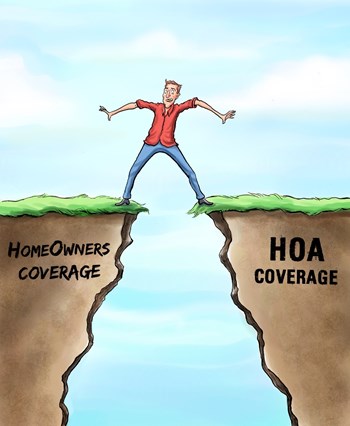
Insurance is designed to be there for us when we need it most. Without knowing the full extent of our coverage, though, we may find ourselves with less protection than we thought. For condominium owners, it is imperative to understand exactly what liabilities and risks are covered by individual resident homeowner policies and what is covered by the building’s policy.
“Unfortunately, many unit owners are under the assumption that the association will insure their entire unit and all of their personal items—this is incorrect!” says Jennifer Eilert, commercial lines manager at CISA Insurance in Elgin.
“The most common misconception of unit owners is that they do not understand how much of the inside of the building itself they are responsible to insure,” says Charles J. Hruska III, president of Hruska Insurancenter, Inc. in Mokena. “As an example, any buildout or updates done by themselves or any previous owner are theirs to insure.”
Knowing exactly what is protected and by whose policies is imperative in ensuring that properties and possessions are in good hands should an emergency arise.
Know Your Insurance
In order to avoid problems later, it is important for unit owners to learn as much as they can about their own policy, their building’s policies and where any gaps may exist. The responsibilities of the resident will vary depending on the type of community they reside in.
“There are three types of community associations and it is important not to define the types of community association by appearance, but rather the legal ownership,” explains Eilert. “The first two are a condominium and a cooperative, in which the association or corporation typically insures the structure itself including the interior walls within the unit, the cabinets, countertops, plumbing fixtures, and electrical fixtures. However, the association/corporation policy will typically not insure the wall coverings, floor coverings and improvements and betterments. Therefore, those items should typically be insured by the unit owner/shareholder in addition to their personal property.”
“Unfortunately, despite Section 12 (a)(1) of the Illinois Condominium Property Act (ICPA) that allows associations’ to provide insurance to their unit owners on a “bare walls” basis, which helps mitigate association losses, and lowers associations’ premiums; there are still several insurance companies that prefer to provide coverage based on the association declarations and bylaws. So many times floor coverings, cabinets, countertops and fixtures can be included or excluded by the association's policy. It is important to review this with the association's insurance agent,” she adds.
“The third type of ownership is a homeowners association. An HOA’s insurance policy insures only the associations’ common areas which includes any association structures like clubhouses, pool houses and gazebos. An HOA never insures the individual unit owner's homes or town home. The homeowners need a homeowner’s policy to insure the entire structure of their home and their personal property,” she says.
Hruska explains that at the very least residents should responsible for decorating, window treatments and all flooring installed on top of the base floorboards. “You must also insure any improvements and betterments, additions and alterations, fixtures, appliances, cabinetry, trim, interior doors, walls or surfaces installed by either you or any past unit owner,” he says.
After determining what their coverage responsibility is, “a unit owner then needs to calculate how much it would cost to rebuild that if necessary,” says Hruska. “As a very rough rule of thumb, we recommend a minimum of $50 per square foot but that needs to be increased if the unit was extensively remodeled and/or with expensive materials. If the unit is essentially “just as the developer handed it over” then they may not need as much. However we always recommend that when in doubt buy more. An additional $10,000 usually only costs $10-$20 more premium per year.”
In the event of a fire, tornado or other catastrophe, whose policy will cover what “depends on what type of association one lives in and on the language in the governing documents for that association,” says Ron Sirotzki, commercial sales manager at Hollinger Services, Inc. in Elk Grove Village. “Typically a homeowner association or a townhome association insurance policy would not provide any property coverage for a resident/unit owner. Consequently a resident/unit owner would need to purchase a homeowner HO-3 policy to cover the dwelling and their personal property. For residents/unit owners of a condominium association they would need to purchase a condominium unit owner HO-6 policy to cover their personal property along with the improvements and betterments made to the unit.” He adds that per the Illinois Condominium Property Act, the association’s insurance policy must be a Special Form policy, which must cover up to the bare walls, bare floors and bare ceiling including the original built in fixtures of the unit. “For that reason a condominium unit owner must insure the finish on the walls, floors, ceiling and any additions made to their unit,” he says.
Understanding the ins and outs of these policies will avoid surprises later. “The board of directors has a responsibility to provide the necessary insurance information to the unit owners so they can ensure they are obtaining the proper and adequate insurance coverage for their unit. The property manager should have the responsibility to make sure this information is disseminated to the unit owners,” says Eilert.
“The best solution for all parties is to ask their current insurance agent to provide a brief letter to the unit owners explaining what is or is not covered for the manager to disperse accordingly. The board of directors or the property manager can also ask the association’s insurance agent to attend a meeting and make them available to the unit owners for a Q&A session,” she says.
Sirotzki agrees saying, “The association’s insurance agent should be there to explain to each and every homeowner their insurance responsibilities. That insurance agent should also be able to explain to the homeowner what is covered and what is not covered by the association’s insurance policy. Lastly, the association’s insurance agent may from time to time need to get involved with the homeowner’s insurance carrier when adjusting a claim.”
It is also necessary for the board to update and review the building policy to any new additions or alterations have been accounted for. “Life is full of change and therefore it is highly recommended to review insurance needs at least once a year. For example, the board may have more money in reserves and thus the employee dishonesty coverage may need to be adjusted. The unit owner may have to adjust their loss of assessment coverage due to the fact that associations raised their insurance deductible, which you as a unit owner could be possibly assessed,” says Sirotzki. “Reviewing insurance does not mean shopping or going out to bid every year. That is something that should be done every three to four years unless of course there is a large premium increase or the service is below par.”
The Proper Coverage
For associations, the goal is to have not only their own insurance responsibilities in order but to encourage unit owners to have their individual policies in order as well. In Illinois, the ICPA provides some guidelines pertaining to insurance coverage.
“The Illinois Condominium Property Act Section 12, (h) provides the ability to the board of directors to require mandatory unit owner coverage under their declarations, bylaws or by rule. If the current association documents do not meet the terms of the Illinois Condominium Act, and the board of directors wishes to require unit owner coverage, they should contact an experienced community association attorney to make the necessary changes,” says Eilert.
Hruska also stresses the fact that if you rent your unit to others, you must still insure it. “You need to purchase a different type of policy. A rental dwelling policy (DP-3) can protect your property, potential loss of rental income and landlord liability,” he says.
When it comes to the things that matter to us most, insurance is imperative in protecting not only our homes and our possessions but our peace of mind. Knowing what is and is not covered and what we can do to make sure all bases are covered is absolutely key in being prepared for the rainiest of days.
Liz Lent is a freelance writer and a frequent contributor to The Chicagoland Cooperator. Editorial Assistant Maggie Puniewska contributed to this article.





Leave a Comment